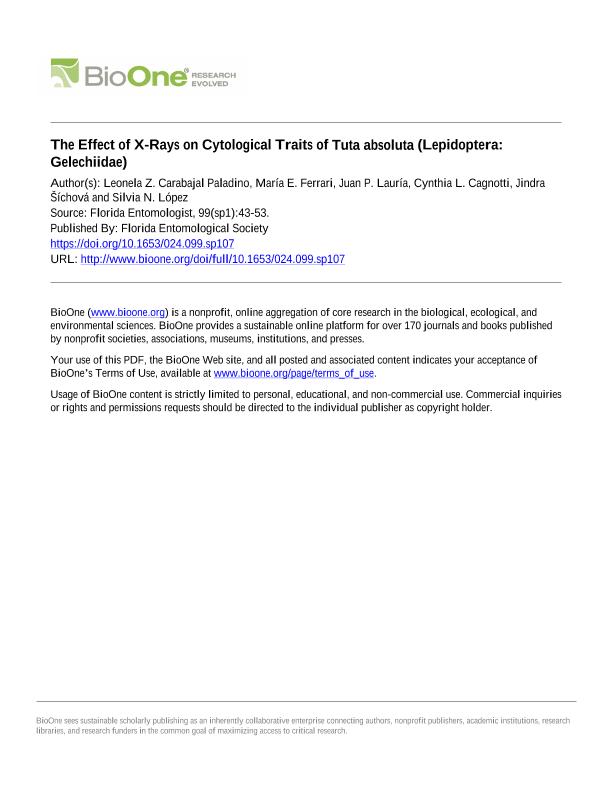Mostrar el registro sencillo del ítem
dc.contributor.author
Carabajal Paladino, Leonela Zusel

dc.contributor.author
Ferrari, María Edith

dc.contributor.author
Lauría, Juan P.
dc.contributor.author
Cagnotti, Cynthia Lorena

dc.contributor.author
Síchová, Jindra
dc.contributor.author
López, Silvia Noelí

dc.date.available
2018-06-28T13:57:04Z
dc.date.issued
2016-06
dc.identifier.citation
Carabajal Paladino, Leonela Zusel; Ferrari, María Edith; Lauría, Juan P.; Cagnotti, Cynthia Lorena; Síchová, Jindra; et al.; The Effect of X-Rays on Cytological Traits of Tuta absoluta (Lepidoptera: Gelechiidae); Florida Entomological Society; Florida Entomologist; 99; 6-2016; 43-53
dc.identifier.issn
0015-4040
dc.identifier.uri
http://hdl.handle.net/11336/50323
dc.description.abstract
The tomato leafminer, Tuta absoluta (Meyrick) (Lepidoptera: Gelechiidae) is one of the most important pests of tomato. With the purpose of developing environmentally friendly control tactics such as the inherited sterility (IS) technique against this species, it is essential to understand its genetics and biology. In this paper we analyzed the karyotype, sperm morphology and sperm ratio in wild-type and X-ray irradiated individuals of T. absoluta. The diploid chromosome number of T. absoluta was 2n = 58 including the pair of sex chromosomes: ZZ in males and WZ in females, which were the largest elements of the complement. Irradiation of pupae in an X-ray machine with a dose of 200 Gy generated various types of chromosomal rearrangements including translocations and fragmentations, resulting in altered chromosome numbers. The analysis of spermatozoa in T. absoluta revealed a significant morphological difference between apyrene and eupyrene sperm bundles. Irradiation with X-ray doses of 100, 150, 200 and 250 Gy did not have a significant effect on the apyrene to eupyrene sperm ratio. However, males irradiated with 300 Gy produced significantly more apyrene sperm than non-irradiated males. All the doses applied influenced the morphology of eupyrene sperm bundles. The modified eupyrene sperm bundles could be used as a bioindicator during the monitoring of an IS program after the release of irradiated males. We found that the modified eupyrene spermatozoa were transferred to the bursae copulatrices of the females. Males treated with 200 Gy transferred a greater proportion of modified eupyrene sperm than untreated males. The results presented herein provide essential information on the cytology of T. absoluta, which is required to evaluate the quality of the released insects, and for better understanding and application of IS against this economically important pest.
dc.format
application/pdf
dc.language.iso
eng
dc.publisher
Florida Entomological Society

dc.rights
info:eu-repo/semantics/openAccess
dc.rights.uri
https://creativecommons.org/licenses/by-nc-sa/2.5/ar/
dc.subject
Apyrene Sperm
dc.subject
Chromosomal Aberrations
dc.subject
Eupyrene Sperm
dc.subject
Inherited Sterility
dc.subject
Karyotype
dc.subject
Tomato Leaf Miner
dc.subject.classification
Otras Ciencias Biológicas

dc.subject.classification
Ciencias Biológicas

dc.subject.classification
CIENCIAS NATURALES Y EXACTAS

dc.title
The Effect of X-Rays on Cytological Traits of Tuta absoluta (Lepidoptera: Gelechiidae)
dc.type
info:eu-repo/semantics/article
dc.type
info:ar-repo/semantics/artículo
dc.type
info:eu-repo/semantics/publishedVersion
dc.date.updated
2018-06-26T22:34:11Z
dc.journal.volume
99
dc.journal.pagination
43-53
dc.journal.pais
Estados Unidos

dc.journal.ciudad
Nueva York
dc.description.fil
Fil: Carabajal Paladino, Leonela Zusel. Consejo Nacional de Investigaciones Científicas y Técnicas; Argentina. Ceske Budejovice; República Checa
dc.description.fil
Fil: Ferrari, María Edith. Consejo Nacional de Investigaciones Científicas y Técnicas; Argentina. Universidad Nacional de Rosario. Facultad de Ciencias Bioquímicas y Farmacéuticas; Argentina
dc.description.fil
Fil: Lauría, Juan P.. Instituto Nacional de Tecnología Agropecuaria. Centro de Investigación en Ciencias Veterinarias y Agronómicas. Instituto de Genética; Argentina
dc.description.fil
Fil: Cagnotti, Cynthia Lorena. Consejo Nacional de Investigaciones Científicas y Técnicas; Argentina. Instituto Nacional de Tecnología Agropecuaria. Centro de Investigación en Ciencias Veterinarias y Agronómicas. Instituto de Microbiología y Zoología Agrícola; Argentina
dc.description.fil
Fil: Síchová, Jindra. Ceske Budejovice; República Checa. University of South Bohemia; República Checa
dc.description.fil
Fil: López, Silvia Noelí. Consejo Nacional de Investigaciones Científicas y Técnicas; Argentina. Instituto Nacional de Tecnología Agropecuaria. Centro de Investigación en Ciencias Veterinarias y Agronómicas. Instituto de Microbiología y Zoología Agrícola; Argentina
dc.journal.title
Florida Entomologist

dc.relation.alternativeid
info:eu-repo/semantics/altIdentifier/doi/https://dx.doi.org/10.1653/024.099.sp107
dc.relation.alternativeid
info:eu-repo/semantics/altIdentifier/url/http://www.bioone.org/doi/10.1653/024.099.sp107
Archivos asociados
